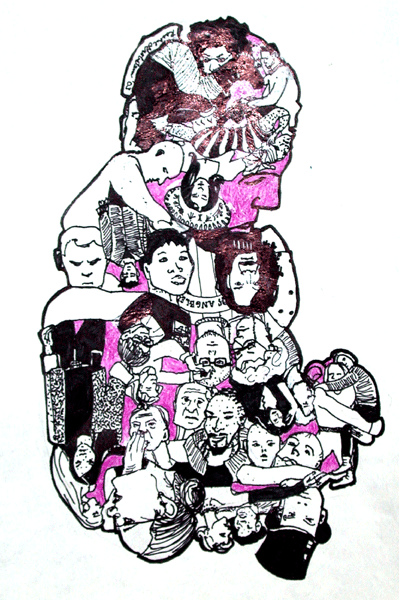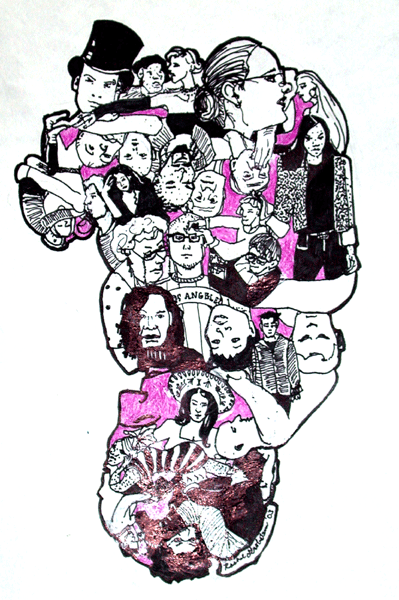Made available on Serendip
In association with Making Sense of Diversity: An Exploration, a world wide conversation
During the summer of 2004, Paula, Alnisa, Lauren and Nia participated in the International Human Rights Exchange Program, spending four weeks at the University of Cape Town, a historically white school that is the "richest university in all Africa." They found themselves in a "beautiful city" which included townships which "made American ghettos look like the Hamptons." The American students roomed with Africans, but the students (the women more than the men) kept themselves divided themselves in groups defined by social and national boundaries. Race was "very complexly defined" in South Africa; there were "many variables," including quite a bit of tension between African and African American women, who were called "coconuts" (=brown on the outside). There was "no great brotherhood" operating among the students.
The three categories of apartheid are still operative in South Africa: there are blacks, whites and coloreds (from South Asia and India; also people of mixed race ancestry), who are distinguished not only by skin color, but by cultural and linguistic differences, and who are proud of their identity. There are historical fissures, however, which persist: coloreds say that they were "not white enough before, and are not black enough after apartheid." Despite the fact that they shared in the fight to end apartheid, they are not recipients of the affirmative action which followed.
It was an interesting experience for Lauren to be a minority (in a country where whites still hold economic power); for Paula to be taken as colored; and for Alnisa and Nia who, as African American women, found it particularly complicated to be in South Africa: they wanted to blend, but there were bets that they "wouldn't survive in Africa," and they "tried not to be princesses." They were also aware that their experience was of "Africa Lite," with most of the comforts of home still available to them. What Nia, Lauren, Alnisa and Paula all learned was that race is ambiguous, and dependent on context; it is a social construction. Some Indians think of themselves as black, for instance, because they shared, with blacks, the experience of being oppressed, and the category for them is an index of that status.
Being abroad, the Bryn Mawr students had a very strong sense of realization that they were American; people spoke admiringly of "your money and your great democracy." South Africans made a distinction between the US government and the people living under it; they saw a difference between who we are and how we represent ourselves. The experience of the American students was also one of often feeling ignorant and stupid; they were ashamed at how little they knew of the world, in comparison with the amount of knowledge the South African students had about the global community and their place in it. It was helpful to study human rights from the South African perspective; these students know that the future of their country depends on them; they know that they "have to get it together," that the shaping of the world is in their hands. They are struggling with very serious questions that have no answers: how to live, how to be citizens in this world? Their agency seems to come from being conscious and critical. Despite the fact that there was "no justice" as a result of the Truth and Reconciliation commission, there is a sense of hopefulness there that is not felt here. Growing up in South African in a politically conscious time, these students have a strong sense of their responsibility for the future of their country. They have seen the struggle, and lived it. Perhaps their strong sense of agency comes from the recent legislation which has changed many things in South Africa? Admittedly, these students were the elite.
The socioeconomic backgrounds of African and American students
varied, ranging from poor to affluent. Economic disparities were sometimes apparent, for instance when some of the American students went to visit Robbins Island, and some of the South Africans were unable to, because it is so expensive to get there. Students would have experienced a "different reality" in Johannesburg, where the resident black population is
much doing better than it is in Cape Town.
The American students learned, too about the intersectionality of identity, about the relationship, for instance, of gender studies to critical race work. Homophobia is a huge issue in South Africa; that difference is unallowable. African males perceived a South African lesbian, for instance, as male, and insisted on refering to her as "he"; someone who would be a "big dyke" at Bryn Mawr was, in their frame of reference, a guy. And yet, the South African constitution is (the only?) one in the world in whih sexual orientation is a protected category.
The most intractable problem in South Africa is AIDS. South Africa has the largest AIDS population in the world; the students learned from a presentation of the TAC (Treatment Action Campaign) that the kinds of "triple cocktails" which keep people alive in the US are not readily available in Africa; people are dying because such medication is not affordable there. AIDS is presented as being the result of poverty; it is not acknowledged that this is a national crisis. AIDS is discussed as a female problem: women are taught that they can negotiate the relationship and chose protection, when often--for monetary or affectional reasons--they do not have that freedom.
This discussion invited to continue on line.
"Making Sense of Diversity" will resume in person at noon on Friday, November 19, when
Posse students, Jody Cohen and Nell Anderson will be talking about Posse On Campus.
| Return to Schedule for Friday Noon Conversations
| Forum
| Bryn Mawr Conversation
| General Conversation
| Serendip Home |
These pages are being maintained by Christina Florio, with support from Audrey Flattes and Nia Turner and sponsored by the Bryn Mawr College Center for Science and Society and the Serendip website. Send us additional comments or suggestions at Serendip
© by Serendip 1994-2004 - Last Modified:
Sunday, 07-Nov-2004 15:28:23 EDT

